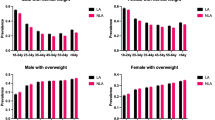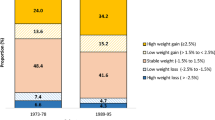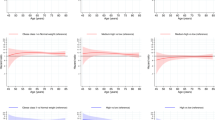Abstract
Background/Objectives:
There is little research on the demographic characteristics and morbidity of people categorized as ‘underweight’ from their body mass index (BMI) although they have often been shown to have greater mortality. This uncertainty makes it difficult to determine whether to include or exclude these individuals when estimating the health and mortality impacts of BMI. This project compares the demographic characteristics and morbidity patterns of the underweight with those of acceptable weight and the overweight.
Subjects/Methods:
Data on 10 243 community-living residents from the Health Survey for England (2003) were used. Logistic regression models were constructed to compare demographic, biochemical and anthropometric factors in the underweight (BMI<18.5) with those classified as acceptable weight (BMI 18.5–24.9) or overweight (BMI 25.0–29.9).
Results:
Univariate analyses found, when compared with other BMI categories, underweight individuals were significantly younger, more likely to smoke, alcohol abstainers, inactive, poorer and were less likely to be ethnically white (all P<0.001). U-shaped relationships between BMI and activities of daily living, respiratory disease, physical activity and mental health variables were seen. In multivariate analysis, the fewest number of significant differences in demographic and morbidity factors were between the underweight and those of acceptable weight.
Conclusions:
We recognize that these are cross-sectional data and exclude individuals in institutional settings, but these findings are important. Overall, we could not conclude that the underweight were less healthy than individuals in the other BMI categories. We cannot therefore recommend that the underweight should be excluded from analyses that examine the effects of obesity on mortality.
This is a preview of subscription content, access via your institution
Access options
Subscribe to this journal
Receive 12 print issues and online access
$259.00 per year
only $21.58 per issue
Buy this article
- Purchase on Springer Link
- Instant access to full article PDF
Prices may be subject to local taxes which are calculated during checkout
Similar content being viewed by others
References
Ali SM, Lindstrom M (2005). Socioeconomic, pyschosocial, behavioural, and psychological determinants of BMI among young women: differing patterns for underweight and overweight/obesity. Eur J Pub Health 16, 324–330.
Bondy SJ, Rehm J, Ashley MJ, Walsh G, Single E, Room R (1999). Low-risk guidelines: the scientific evidence. Can J Public Health 90, 264–270.
Flegel KM, Graubard BI, Williamson DF, Gail MH (2005). Excess deaths associated with underweight, overweight, and obesity. JAMA 293, 1861–1867.
Foresight Programme. Foresight. Tackling Obesities: Future Choices. Government Office for Science, Department of Innovation Universities and Skills: London. Project Report. 2007 p 164.
Freedman DM, Ron E, Ballard-Barbash R, Doody MM, Linet MS (2006). Body mass index and all-cause mortality in a nationwide US cohort. Int J Obes 30, 822–829.
Golderberg D, Williams P (1988). A User's Guide to the General Health Questionnaire. NFER-Nelson: Windsor, UK.
Groessl EJ, Kaplan RM, Barrett-Connor E, Ganiats TG (2004). Body mass index and quality of well-being in a community of older adults. Am J Prev Med 26, 126–129.
Gu D, He J, Duan X, Reynolds K, Wu X, Chen J et al. (2006). Body weight and mortality among men and women in China. JAMA 295, 776–783.
Heo M, Allison DB, Faith MS, Zhu S, Fontaine KR (2003). Obesity and quality of life: mediating effects of pain and comorbidities. Obesity Res 11, 209–216.
Hjartaker A, Adami H-O, Lund E, Weiderpass E (2005). Body mass index and mortality in a prospectively studied cohort of Scandinavian women: the women's lifestyle and health cohort study. Eur J Epidemiol 20, 747–754.
Jonsson S, Hedblad B, Engstrom G, Nilsson P, Berglund G, Janzon L (2002). Influence of obesity on cardiovascular risk. Twenty-three-year follow-up of 22 025 men from an urban Swedish population. Int J Obes 26, 1046–1053.
Kaplan MS, Huguet N, Newsom JT, McFarland BH (2003). Characteristics of physically inactive older adults with arthritis: results of a population-based study. Prev Med 37, 61–67.
Kelly SJ (2003). Self-Reported Health: Stitching Together a Picture from the Fabric of Life. University of British Columbia: Vancouver.
Kress AM, Peterson MR, Hartzell MC (2006). Association between obesity and depressive symptoms among US Military active duty service personnel 2002. J Psychosom Res 60, 263–271.
LaCousiere DY, Baksh L, Bloebaum L, Varner MW (2006). Maternal body mass index and self-reported postpartum depressive symptoms. Matern Child Health J 10, 385–390.
Linares C, Su D (2005). Body mass index and health among Union Army veterans: 1891–1905. Econ Hum Biol 3, 367–387.
Okoro CA, Hootman JM, Strine TW, Balluz LS, Mokad AH (2004). Disability, arthritis, and body weight among adults 45 years and older. Obes Res 12, 854–861.
Reidpath DD, Crawford D, Tilgner L, Gibbons C (2002). Relationship between body mass index and the use of healthcare services in Australia. Obes Res 10, 526–531.
Schmid A, Weiss M, Heseker H (2003). Recording the nutrient intake of nursing home residents by food weighing method and measuring the physical activity. J Nutri Health Aging 7, 294–295.
UK Department of Health (2003). Health Survey for England, 2003. The Stationary Office: Norwich, UK.
UK National Statistics. Health Survey for England: Summary of Key Findings, 2003.
Yan LL, Daviglus ML, Liu K, Pirzada A, Garside DB, Schiffer L et al. (2004). BMI and health-related quality of life in adults 65 years and older. Obes Res 12, 69–76.
Acknowledgements
The study was funded internally by the University of Nottingham.
Author information
Authors and Affiliations
Corresponding author
Ethics declarations
Competing interests
The authors declare no conflict of interest.
Additional information
Contributors: SJK had overall responsibility, JLB conducted the statistical analyses and all the authors conceived of the project, discussed the findings and wrote it up.
Rights and permissions
About this article
Cite this article
Kelly, S., Lilley, J. & Leonardi-Bee, J. Associations of morbidity in the underweight. Eur J Clin Nutr 64, 475–482 (2010). https://doi.org/10.1038/ejcn.2010.13
Received:
Revised:
Accepted:
Published:
Issue Date:
DOI: https://doi.org/10.1038/ejcn.2010.13
Keywords
This article is cited by
-
Association between BMI trajectories in late-middle age and subsequent dementia risk in older age: a 26-year population-based cohort study
BMC Geriatrics (2023)
-
Nationwide trends in prevalence of underweight, overweight, and obesity among people with disabilities in South Korea from 2008 to 2017
International Journal of Obesity (2022)
-
Association between underweight and pulmonary function in 282,135 healthy adults: A cross-sectional study in Korean population
Scientific Reports (2019)
-
Mortality risk associated with underweight: a census-linked cohort of 31,578 individuals with up to 32 years of follow-up
BMC Public Health (2014)
-
Alterations of body mass index and body composition in atomic bomb survivors
International Journal of Obesity (2013)



